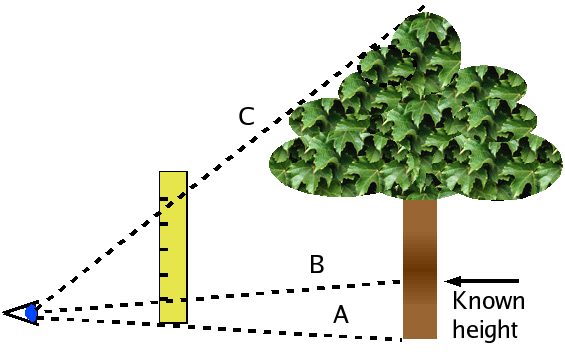The main reason for wishing to estimate the height of a tree and the width of a stream would be so that you could cut down a tree and use it as a bridge to cross the stream. Of course, a responsible outdoors person would never do this without permission from the landowner, and even then, only after careful consideration. How unfortunate for you though, if you cut down a tree that was not tall enough to span the stream, and what a waste of a good tree if it were too long!
Height Estimation, Method 1
In the first method presented here, you will need a ruler, or any object with evenly spaced markings on it. Walk up to the tree, and estimate a point on it that is a mathematically convenient height from the ground (say five feet, or two meters). Mark that spot so that you can see it clearly from a distance by tying a rope around the tree at that height.
Next, walk away from the tree so that you can see its top. Hold the ruler in front of your face, such that the line of sight from your eye to the base of the tree crosses the “0” mark on the ruler. This is line A in the diagram. Then move the ruler either towards or away from your eye until the line from your eye to the rope you tied to the tree crosses the “1” mark on the ruler. This is line B in the diagram. When the ruler is positioned correctly such that lines A and B point to the base and the known height, glance up and note the measurement where the line from your eye to the top of the tree (line C in the diagram) crosses the ruler. Do this without moving the ruler or your head. When you have this measurement, multiply it by the mathematically convenient height you selected in the beginning. This is the height of the tree.
For instance, suppose you selected 2 meters as the known height on the tree, and line C crossed the 4.5 mark on the ruler:

Height Estimation, Method 2
In the second method for estimating height presented here, you will need a sheet of paper. Fold the paper so that the left edge meets the bottom edge, forming a 45° angle. Sight along the bottom of the paper so that line A in the diagram points to the base of the tree. Then move closer to or farther from the tree until the line through the fold points to the top of the tree (line B in the diagram).
Be careful to not poke yourself in the eye with the corner of the paper. In fact, it would be prudent to cut off the corner. The angle will still be correct even without it.
When the bottom of the paper points to the bottom of the tree, and the fold in the paper points to the treetop, the distance between you and the tree equals the height of the tree. Estimate this distance by pacing it off. Every two steps is roughly 5 feet, or if you prefer metric, every step is roughly 75 cm (which means every fourth step is about 3 meters). For more precision, measure your stride and use that figure.
Width Estimation, Method 1
The first method we present here for estimating the width of a stream will involve choosing an easily seen marker on the opposite side, and designating is “Marker A”. Place a second marker (B) directly across the stream from marker A, and the place two more markers (C & D) along the stream bank at equal intervals. That is, be sure that the distance from B to C equals the distance from C to D. Also, try to form a 90° angle from A to B to C. Walk away from the stream at 90° from line B-D until you can see that markers A and C line up. Mark the place where this happens with marker E. If your 90° angles are accurate and the distance from B-C and C-D are equal, the distance between E-D will equal the distance between A-B (which is the width of the stream).
Width Estimation, Method 2
Method 2 for estimating the width of a stream is exactly the same as method 2 for estimating the height of a tree, except that the paper is held horizontally instead of vertically. Find a marker on the opposite side of the stream to serve as the “treetop” (this could be a rock or a tree), and mark a spot on your side of the stream bank directly across from the marker on the other side. Walk along the stream bank as you sight along the bottom edge of the folded paper to the mark on your side, and sight along the folded edge to the marker on the opposite side. Move away from the marker until both line up. Then pace off the distance between you and the marker on your side. This will be equal to the distance across the stream.
Source



